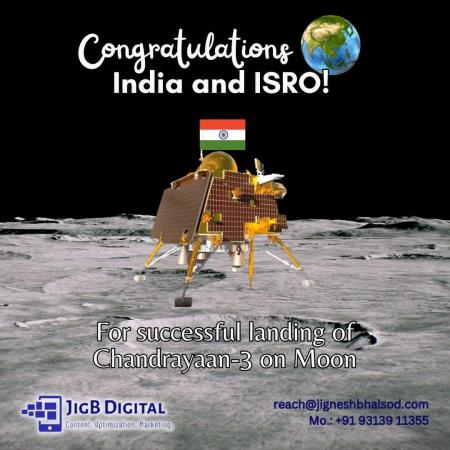
India's Chandrayaan-3 mission made history and a new milestone in India's Space Program on August 23, 2023, when it successfully landed on the Moon's south pole. The landing was the culmination of years of hard work and dedication by the Indian Space Research Organisation (ISRO) and its team of scientists and engineers.
The Chandrayaan-3 Mission
The Chandrayaan-3 mission is India's third lunar mission and its first attempt to soft-land on the Moon's south pole. The South Pole is a region of the Moon that is of particular interest to scientists because it is thought to be rich in water ice. Water ice is a valuable resource that could be used to support future human missions to the Moon.
The Chandrayaan-3 lander, named Vikram, touched down on the Moon's south pole at 18:04 IST. The landing was followed by the deployment of the Pragyan rover, which will explore the surrounding area. The rover is equipped with a variety of instruments that will be used to study the geology, mineralogy, and water content of the lunar south pole.
The Successful Landing
The successful landing of Chandrayaan-3 is a major achievement for India and a significant step forward in the global exploration of space. The mission is a testament to the skill and dedication of the ISRO team and it has inspired pride and excitement among Indians around the world.
The Future of India's Space Program
The future plans of ISRO and India in space are ambitious. The space agency is currently working on a number of projects, including a mission to Mars and a human lunar mission. The successful landing of Chandrayaan-3 has given ISRO a major boost and it is expected to accelerate the pace of India's space program.
Future space programs of India:
Gaganyaan
India's first human spaceflight mission is scheduled to launch in 2024. The mission will send three astronauts into orbit around the Moon.
Aditya L1
This mission will launch a space telescope to study the Sun. The telescope will be placed in a halo orbit around the Sun-Earth Lagrange point 1 (L1).
NISAR
This mission will launch a joint India-US radar satellite to study the Earth's surface and subsurface. The satellite will be equipped with a synthetic aperture radar (SAR) that can image the Earth's surface in detail, even at night or through clouds.
Shukrayaan-1
This mission will launch an orbiter to study Venus. The orbiter will be equipped with a variety of instruments to study the planet's atmosphere, surface, and interior.
Mangalyaan 2
This mission will launch a Mars orbiter to study the Red Planet. The orbiter will be equipped with a variety of instruments to study the planet's atmosphere, surface, and potential for life.
These are just a few of the many future space programs that are being planned by ISRO. The space agency is committed to continuing to push the boundaries of space exploration and to making India a major player in the global space race.
Conclusion
The successful landing of Chandrayaan-3 is a major milestone in India's space program and it is a source of great pride for Indians around the world. The mission has also shown the world that India is a major player in the global space race. The future plans of ISRO and India in space are ambitious and they are sure to have a significant impact on the world.
I hope this article was informative and exciting. I hope it inspired you to learn more about India's space program and to support the future of space exploration.
Main image by JigB Digital


